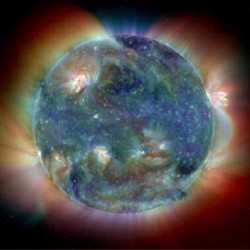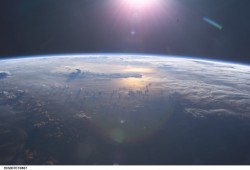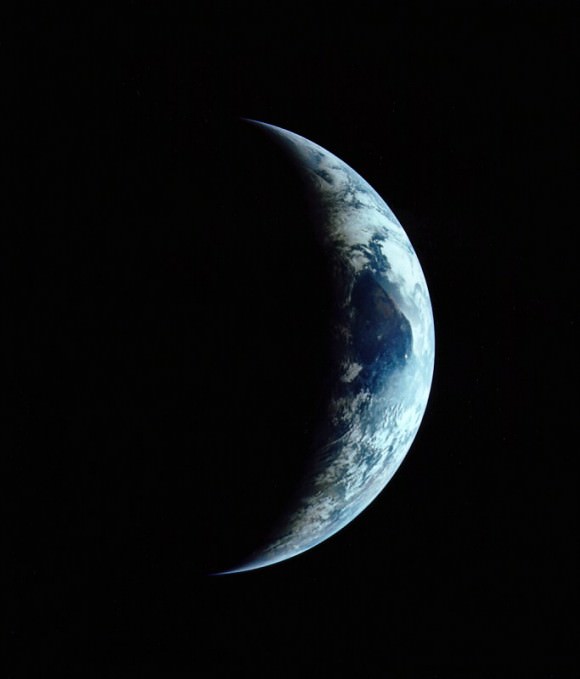For Goldilocks, the porridge had to be not too hot, and not too cold … the right temperature was all she needed.
For an Earth-like planet to harbor life, or multicellular life, certainly temperature is important, but what else is important? And what makes the temperature of an exo-Earth “just right”?
Some recent studies have concluded that answering these questions can be surprisingly difficult, and that some of the answers are surprisingly curious.
Consider the tilt of an exo-Earth’s axis, its obliquity.

In the “Rare Earth” hypothesis, this is a Goldilocks criterion; unless the tilt is kept stable (by a moon like our Moon), and at a “just right” angle, the climates will swing too wildly for multicellular life to form: too many snowball Earths (the whole globe covered in snow and ice with an enhanced albedo effect), or too much risk of a runaway greenhouse.
“We find that planets with small ocean fractions or polar continents can experience very severe seasonal climatic variations,” Columbia University’s David Spiegel writes*, summing up the results of an extensive series of models investigating the effects of obliquity, land/ocean coverage, and rotation on Earth-like planets, “but that these planets also might maintain seasonally and regionally habitable conditions over a larger range of orbital radii than more Earth-like planets.” And the real surprise? “Our results provide indications that the modeled climates are somewhat less prone to dynamical snowball transitions at high obliquity.” In other words, an exo-Earth tilted nearly right over (much like Uranus) may be less likely to suffer snowball Earth events than our, Goldilocks, Earth!

Consider ultra-violet radiation.
“Ultraviolet radiation is a double-edged sword to life. If it is too strong, the terrestrial biological systems will be damaged. And if it is too weak, the synthesis of many biochemical compounds cannot go along,” says Jianpo Guo of China’s Yunnan Observatory** “For the host stars with effective temperatures lower than 4,600 K, the ultraviolet habitable zones are closer than the habitable zones. For the host stars with effective temperatures higher than 7,137 K, the ultraviolet habitable zones are farther than the habitable zones.” This result doesn’t change what we already knew about habitability zones around main sequence stars, but it effectively rules out the possibility of life on planets around post-red giant stars (assuming any could survive their homesun going red giant!)

Consider the effects of clouds.
Calculations of the habitability zones – the radii of the orbits of an exo-Earth, around its homesun – for main sequence stars usually assume an astronomers’ heaven – permanent clear skies (i.e. no clouds). But Earth has clouds, and clouds most definitely have an effect on average global temperatures! “The albedo effect is only weakly dependent on the incident stellar spectra because the optical properties (especially the scattering albedo) remain almost constant in the wavelength range of the maximum of the incident stellar radiation,” a German team’s recent study*** on the effects of clouds on habitability concludes (they looked at main sequence homesuns of spectral classes F, G, K, and M). This sounds like Gaia is Goldilocks’ friend; however, “The greenhouse effect of the high-level cloud on the other hand depends on the temperatures of the lower atmosphere, which in turn are an indirect consequence of the different types of central stars,” the team concludes (remember that an exo-Earth’s global temperature depends upon both the albedo and greenhouse effects). So, the take-home message? “Planets with Earth-like clouds in their atmospheres can be located closer to the central star or farther away compared to planets with clear sky atmospheres. The change in distance depends on the type of cloud. In general, low-level clouds result in a decrease of distance because of their albedo effect, while the high-level clouds lead to an increase in distance.”
“Just right” is tricky to pin down.
* lead author; Princeton University’s Kristen Manou and Colombia University’s Caleb Scharf are the co-authors (“Habitable Climates: The Influence of Obliquity”, The Astrophysical Journal, Volume 691, Issue 1, pp. 596-610 (2009); arXiv:0807.4180 is the preprint)
** lead author; Fenghui Zhang, Xianfei Zhang, and Zhanwen Han, all also at the Yunnan Observatory, are the co-authors (“Habitable zones and UV habitable zones around host stars”, Astrophysics and Space Science, Volume 325, Number 1, pp. 25-30 (2010))
*** “Clouds in the atmospheres of extrasolar planets. I. Climatic effects of multi-layered clouds for Earth-like planets and implications for habitable zones”, Kitzmann et al., accepted for publication in Astronomy & Astrophysics (2010); arXiv:1002.2927 is the preprint.


when will they finally realize that there are millions of exotic combinations of conditions that could harbor life? it’s just the perfect combination of effects that matters. there’s nothing like a robust, life-supporting combination of conditions. even our earth was not very friendly place for life all the time. with a little less luck we could have ended up as a giant snowball too!
Of course there may be some range of variation for bio-planets. Many planetary bodies might further contain life, but it is likely a rather small fraction of these are robust bio-planets such as Earth with complex life forms and ecosystems involving billions of species of life. Some range of variability probably exists there as well, and the Earth during the Permian was in many ways quite different from today. The requirement for a moon is an interesting issue. A planet that is not spin stabilized will probably endure climate changes which are quite large. Yet if the amount of continental mass is smaller and oceans more extensive then ocean convections might pump heat around more to thermally stabilize things. In the end we really are not sure about these matters. Maybe data will be coming in from Kepler which indicates some potential bioplanets.
LC
This article assumes that life on such a planet would develop using similar chemical processes and compounds. I think we need to widen our scope.
Plus it doesn’t take into account thermal vents, which may have in fact been the origin of life on Earth. As LC said, the Earth and it’s biology has changed a lot. There might be lots of fledgling bioplanets out there, or planets that have very limited biology. I think these would be more abundant than a well developed, deversified multi-ecosystem planet like ours.
It’s also a good idea to include the possibility of habitable moons of gas giants. Think of a warm Titan or Europa. There will likely be some issues on these moons, such as tidal locking/stress, exposure to radiation belts, being in a deep gravity well of the host planet which pulls in comets, etc…but these might not be so bad. In fact they might be great for certain organisms.
This article makes me fume. Once again we see ‘conclusions’ arrived at after using models with so many variables and the earth used as a baseline against which possible worlds are measured. Futile.
I don’t think the article arrives at conclusions. We need some sort of idea of what we might expect or what to look for. That is a point of these types of ideas. Of course much of this can be wrong, such as Schiaparelli’s ideas of Martian canals and ETs there. In thinking about the occurrence of biology in the universe we have to ponder the extent to which it is repeated and the frequency with which it might evolve into considerable complexity we have on Earth.
LC
Personally, the most frustrating thing is that we still have a sample of one, whether life, proto-life, multi-cellular life, etc, or Earth-like planets.
There’s a counterpart story to this one, that I might still write, on what sort of telescopes, spectroscopes, instrumentation, spacecraft, etc, etc, etc are needed to confidently detect Earth-like planets, plate tectonics, signatures of microbial life, etc.
The point is this: resources are finite, and hard choices have to be made; if we’re serious about looking for life outside our solar system, how do we make those hard choices, to maximize our chances of finding what we seek?
Bravo Jean! We certainly have finite financial resources to work with, and we need to determine the path that will deliver the best bang for the buck in terms of detection of exoplanets. Perhaps people like Paul Eaton-Jones should stick to those areas of science like math where he’ll feel comforted by “conclusions.” Myself, i’d rather speculate about what’s possible in terms of space exploration, not simply what we can “prove. I’m fairly certain much of the advancement that has been made in astronomy are the fruits of a what if attitude.
When it comes to simple life forms Mars is probably the target to shoot for. The Viking crafts got chemical signatures of life, but any detection of life report was retracted. The curious thing is that the outgassing process in the sealed chamber was diurnal with respect to the martian day. That has to make one wonder.
I got my AAAS Science journal yesterday and there is a report on the Kepler data obtained so far. I looked at the paper, but have not really digested it yet. Kepler type probes and maybe spacebased optical interferometers are the way to go.
LC
Seems like the more we muse over the factors which might limit or expand exoplanet bio-potential, the more complex and “abstract” the term Goldilocks zone” becomes!
What about early planetary geology? Correct me if I am wrong, but how early Venus sequestered carbon may have been key to it’s evolution as an inhospitable planet.
Clearly there are many factors to consider. Yet the Goldilocks zone may prove useful in determining how we focus limited resources on potential Earth candidates.
Venus likely was just too hot to permit liquid water, at least for long. 4 billion years ago the sun had about 30% less power output, so Venus might have been similar to an early Earth with liquid water. Yet if it had oceans these likely began boiling off once the sun in its main sequence evolution became more luminous. This probably prevented tectonic activity, which requires water as a lubricant of sorts. Tectonic activity is central for a carbon cycle.
Of course it will be very difficult to assess surface conditions on other planets, other than spectrometry of their atmosphere. Of course it is nearly impossible to speculate with much clarity on how any terrestrial planet might form with properties sufficiently similar to Earth.
LC
So in effect Lawrence, you are proposing Venus is very much how Earth will likely shape up to look like in a few Billion years time.
Sounds like we are in need of probe that can withstand a landing on the Venetian surface and do some geological work. Maybe we should contract this out to the Russians? It is my understanding that they have had more success in this arena….
UF
Yep, that is about it. I discuss this some in my book, but the Earth drifts outwards some by the influence of Jupiter which about compensates for the increased heating of the sun. If the Earth were at .85 AU at its inception then temperatures would be comparable to what we have today, instead of -30C. Yet the solar heating will rise faster than the Earth drifts out, and in about 1.5 billion years things are going to get nasty here. In fact starting about 700 million years things will start getting tough for much of complex life to exist here. 2.5 billion years from now Earth will be a cooler version of Venus with a surface temp of 300C instead of the 600C now on Venus.
LC
Interesting. I had no idea Jupiter could influence our orbit to such a degree.
I can see where this is going. This doesn’t bode well in our search for advanced Extra-terrestrial life on Earth-like planets does it? If another solar system did not have a similar planetary makeup as our own, and suppose the planetary tug of a Jupiter sized world didn’t exist, then does this mean a inner rocky world may have a fleeting existance in the Goldielocks zone?
I imagine there are many factors. Type of star and age of star must not only determine the location and size of the Goldielocks zone, but how fast it extends outward?
This may be a bid vague and open to interpretation but..
LC, in your work, did you by any chance calculate how long the Earth would have remained hospitable had Jupiter not existed (assuming that Earth could have formed without Jupiter and other Jovian influences .. ie. Jupiter’s influence on Solar system debris).
Perhaps we can glen an idea of (averages) what to expect in terms of evolutionary development on a rocky world that is not influenced by a Jovian brother.
That is a possible factor. The ratio of the orbital period of Jupiter to Earth is 11.8, which is close to a resonance condition of 12. These cause trouble for there is a division by zero problem in the classical perturbation theory. This leads to the chaos element to this problem and the existence of a Lyapunov exponent for chaotic drift. I estimate the Earth was at a periodicity ratio of around 15 at the start of the solar system, and it is now past the 12-mark, where may have crossed the last resonance mark about 300Mya, and we will be at a ratio of near 11, where the Earth will be at 1.06AU from the sun in about 1.5 billion years. This will mean the Earth will receive 90% the solar radiation it currently does — if the sun were a constant sun. The problem is that solar luminosity will have increased above this point so the Earth may be getting 5-10% more solar energy and things are going to be too toasty.
I think solar systems have to be fairly fine tuned in a way. The Jovian planet can’t be too close to the star, for that will make any putative 1AU planet unstable. If the jovian is a torch jovian that would pull the terrestrial inwards — no good! I did some stats on this. I wrote computer programs to model the Sol-Jupiter-Earth system and to estimate lypunov exponents of this drift and then used this to estimate the probability for Earth-like planets. Over all I think there might only be a few thousand Earth-like planets in the whole galaxy.
LC
Yes, it seems like such a fine tuning may be a requirement for a long-term stable terrestrial planetary system.
Curious. How much of an influence on our orbit do you postulate Saturn Uranus and Neptune have? Reason would dictate that their influence would be minimal due to their distance. Yet I feel they might be worth considering because of their mass. Have you done any math on these planets?